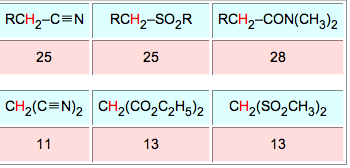 Reactions at the α-Carbon Reactions at the α-Carbon
 1. Enolate Intermediates 1. Enolate Intermediates
 Many of the most useful alpha-substitution reactions of ketones proceeded by way of enolate anion conjugate bases. Since simple ketones are weaker acids than water, their enolate anions are necessarily prepared by reaction with exceptionally strong bases in non-hydroxylic solvents. Many of the most useful alpha-substitution reactions of ketones proceeded by way of enolate anion conjugate bases. Since simple ketones are weaker acids than water, their enolate anions are necessarily prepared by reaction with exceptionally strong bases in non-hydroxylic solvents.
 Esters and nitriles are even weaker alpha-carbon acids than ketones (by over ten thousand times), nevertheless their enolate anions may be prepared and used in a similar fashion. Esters and nitriles are even weaker alpha-carbon acids than ketones (by over ten thousand times), nevertheless their enolate anions may be prepared and used in a similar fashion.
 The presence of additional activating carbonyl functions increases the acidity of the alpha-hydrogens substantially, so that less stringent conditions may be used for enolate anion formation. The influence of various carbonyl and related functional groups on the equilibrium acidity of alpha-hydrogen atoms (colored red) is summarized in the following table. The presence of additional activating carbonyl functions increases the acidity of the alpha-hydrogens substantially, so that less stringent conditions may be used for enolate anion formation. The influence of various carbonyl and related functional groups on the equilibrium acidity of alpha-hydrogen atoms (colored red) is summarized in the following table.
 For common reference, these acidity values have all been extrapolated to water solution, even though the conjugate bases of those compounds having pKas greater than 18 will not have a significant concentration in water solution. For common reference, these acidity values have all been extrapolated to water solution, even though the conjugate bases of those compounds having pKas greater than 18 will not have a significant concentration in water solution.
Acidity of α-Hydrogens in Mono- and Di-Activated Compounds

 
 To illustrate the general nucleophilic reactivity of di-activated enolate anions, two examples of SN2 alkylation reactions are shown below. Malonic acid esters and acetoacetic acid esters are commonly used starting materials, and their usefulness in synthesis will be demonstrated later in this chapter. To illustrate the general nucleophilic reactivity of di-activated enolate anions, two examples of SN2 alkylation reactions are shown below. Malonic acid esters and acetoacetic acid esters are commonly used starting materials, and their usefulness in synthesis will be demonstrated later in this chapter.
 Note that each of these compounds has two acidic alpha-hydrogen atoms (colored red). In the equations written here only one of these hydrogens is substituted; however, the second is also acidic and a second alkyl substitution may be carried out in a similar fashion. Note that each of these compounds has two acidic alpha-hydrogen atoms (colored red). In the equations written here only one of these hydrogens is substituted; however, the second is also acidic and a second alkyl substitution may be carried out in a similar fashion.
|